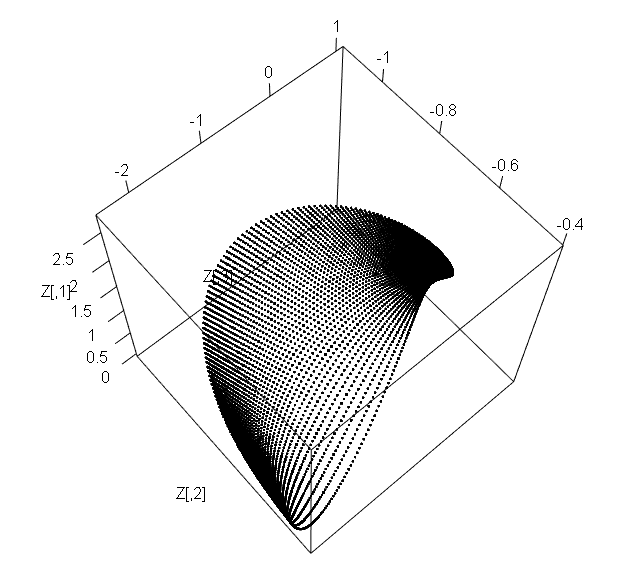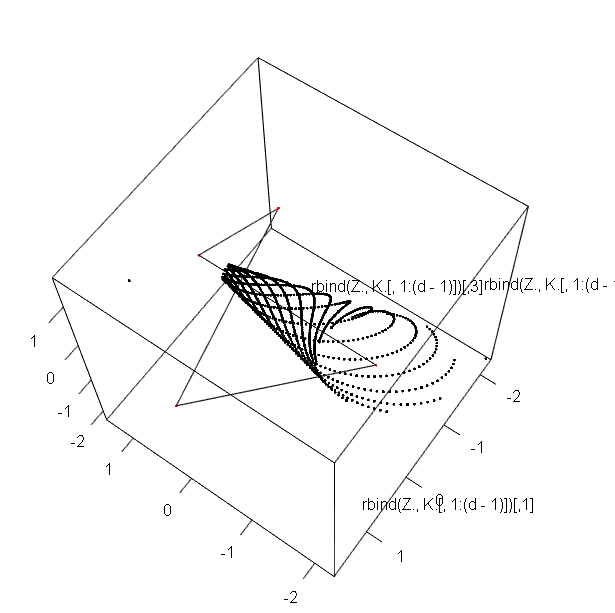- 貝や卵などの形のことをいじるのに、外積代数やら楕円関数やら、ボルツマン等式やらやったけれど、夏休みも終わりなので、元に戻って、貝
- 条件

> M
[,1] [,2] [,3] [,4]
[1,] 1.36836505 0.1216459 0.63585608 -0.5854620
[2,] -0.41765962 -1.7889032 0.21444323 0.6672658
[3,] -0.07303386 -0.9380238 0.03986569 -1.1766080
[4,] -0.47066985 0.4180992 -0.71966843 -1.5985446
> K
[,1] [,2] [,3] [,4]
[1,] -0.1824658 0.2464699 -1.9201338 -2.9316963
[2,] 0.1786383 -0.6043951 0.9368007 0.2924991
[3,] 1.6589981 0.4654187 0.9734282 -0.6336958
[4,] -0.8191066 0.3975617 -0.8525419 -1.1676240
> x.init
[1] 0.3021678 0.5662305 0.5802933 0.2742637
> x.step
[1] 0.07645100 -0.15417863 0.05908368 -0.07654749
exp.m <- function(A,n){
eigen.out<-eigen(A)
V<-eigen.out[[2]]
U<-solve(V)
B<-diag(exp(eigen.out[[1]]*n))
X <- V%*%B%*%U
return(list(matrix = X, eigen.vs <- eigen.out[[1]]))
}
d <- 4
K <- matrix(rnorm(d^2),d,d)
M <- matrix(0,d,d)
a <- 0.9
theta <- pi/7
M[1,1] <- a*cos(theta)
M[1,2] <- -a * sin(theta)
M[2,1] <- -M[1,2]
M[2,2] <- M[1,1]
M[3,3] <- M[4,4] <- 1.1
M. <- matrix(rnorm(d^2),d,d)
M <- M. %*% M
ks <- c(1,1.1,1.2,1.3)
t <- seq(from=-10,to=10,length=1000)
X <- matrix(0,length(t),d)
x.init <- runif(d)
XX <- matrix(0,0,d)
x.step <- rnorm(d)*0.1
n.iter <- 50
for(ii in 1:n.iter){
x.init. <- x.init + x.step*ii*0.2
for(i in 1:length(t)){
X[i,] <- Re(exp.m(M,t[i])[[1]]) %*% x.init.
}
XX <- rbind(XX,X)
}
Y <- t(K %*% t(XX))
Z <- matrix(0,length(XX[,1]),d-1)
for(i in 1:(d-1)){
Z[,i] <- Y[,i]/Y[,d]
}
library(rgl)
plot3d(Z)

> K
[,1] [,2] [,3] [,4]
[1,] 0.8660254 -0.2886751 -0.2886751 -0.2886751
[2,] 0.0000000 0.8164966 -0.4082483 -0.4082483
[3,] 0.0000000 0.0000000 0.7071068 -0.7071068
[4,] 0.5000000 0.5000000 0.5000000 0.5000000
> M
[,1] [,2] [,3] [,4]
[1,] 6.123032e-17 -1.000000e+00 0.000 0e+00
[2,] 1.000000e+00 6.123032e-17 0.000 0e+00
[3,] 0.000000e+00 0.000000e+00 0.001 0e+00
[4,] 0.000000e+00 0.000000e+00 0.000 1e-05
> x.init
[1] 0.9625924 0.4525413 0.3824642 10.4457921
exp.m <- function(A,n){
eigen.out<-eigen(A)
V<-eigen.out[[2]]
U<-solve(V)
B<-diag(exp(eigen.out[[1]]*n))
X <- V%*%B%*%U
return(list(matrix = X, eigen.vs <- eigen.out[[1]]))
}
d <- 4
CategoryVector<-function(d){
df <- d - 1
diagval <- 1:d
diagval <- sqrt((d)/df) * sqrt((d - diagval)/(d - diagval + 1))
others <- -diagval/(d - (1:d))
m <- matrix(rep(others, d), nrow = d, byrow = TRUE)
diag(m) <- diagval
m[upper.tri(m)] <- 0
as.matrix(m[, 1:df])
}
make.simplex.0 <- function(k){
cv <- CategoryVector(k)
rbind(t(cv*sqrt(1-1/k)),rep(1/sqrt(k),k))
}
K <- make.simplex.0(d)
M <- matrix(0,d,d)
a <- 1
theta <- pi/2
M[1,1] <- a*cos(theta)
M[1,2] <- -a * sin(theta)
M[2,1] <- -M[1,2]
M[2,2] <- M[1,1]
M[3:4,3:4] <- diag(c(0.9,0.85))
a2 <- 1.0001
theta2 <- pi/2
M[3,3] <- a2*cos(theta2)
M[3,4] <- -a2 * sin(theta2)
M[4,3] <- -M[3,4]
M[4,4] <- M[3,3]
M[3:4,3:4] <- diag(c(0.001,0.00001))
ks <- c(1,1.1,1.2,1.3)
t <- seq(from=-1000,to=3000,length=1000)
X <- matrix(0,length(t),d)
x.init <- runif(d)
x.init[d] <- x.init[d]+10
XX <- matrix(0,0,d)
x.step <- runif(d)*1
n.iter <- 1
for(ii in 1:n.iter){
x.init. <- x.init + x.step*ii*10
for(i in 1:length(t)){
X[i,] <- Re(exp.m(M,t[i])[[1]] %*% x.init.)
}
XX <- rbind(XX,X)
}
Y <- t(K %*% t(XX))
Z <- matrix(0,length(XX[,1]),d-1)
for(i in 1:(d-1)){
Z[,i] <- Y[,i]/Y[,d]
}
library(rgl)
Z. <- Z
Z. <- rbind(Z.,rep(min(Z),d-1))
Z. <- rbind(Z.,rep(max(Z),d-1))
plot3d(Z.)
K. <- t(K)/K[d,]
plot3d(rbind(Z.,K.[,1:(d-1)]),col=c(rep(1,length(Z.[,1])),rep(2,length(K.[,1]))))
points3d(K.[,1:(d-1)],col=4)
lines3d(rbind(K.[,1:(d-1)],K.[1,1:(d-1)]))

